Process Theories Of Motivation And Business Applications
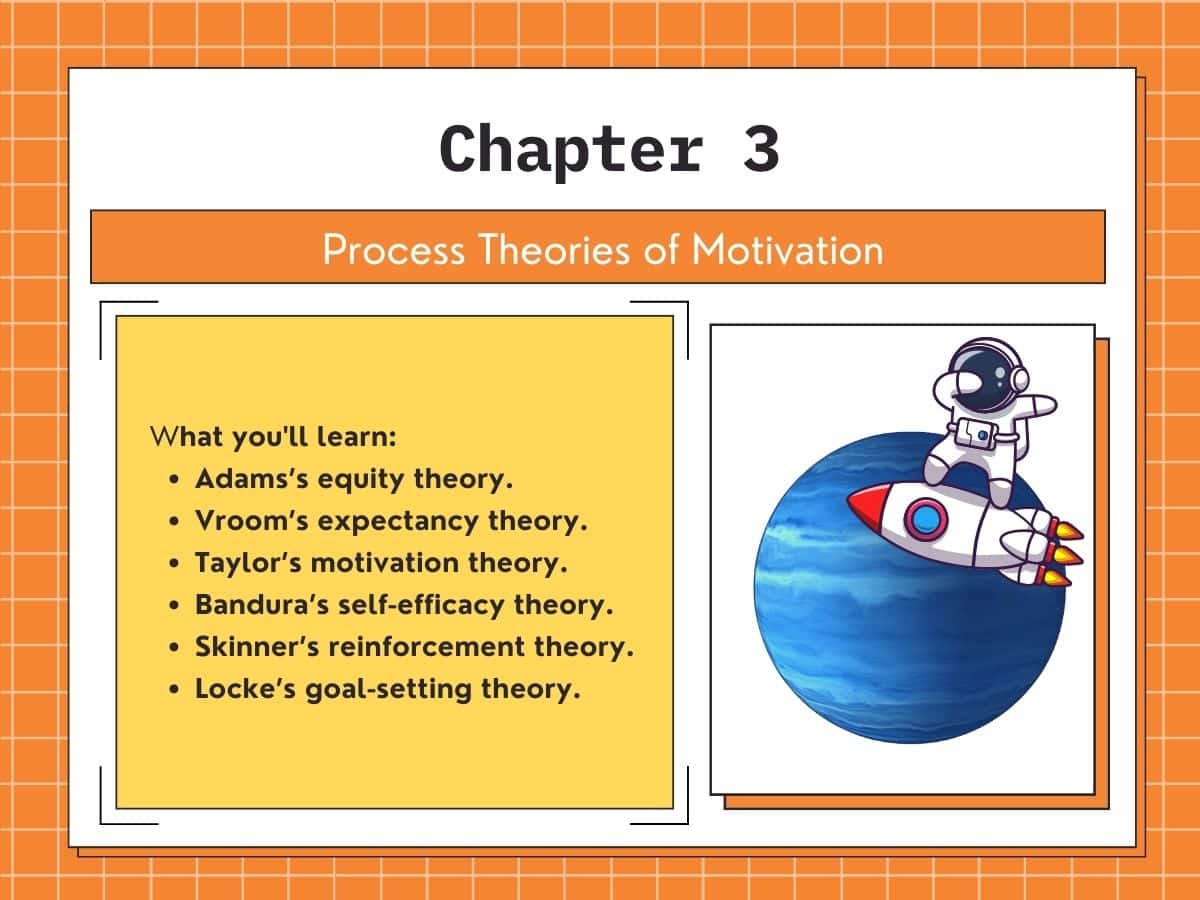
Process theories of motivation focus on explaining the steps through which motivation can be triggered. In Chapter 3 of the Beginner’s Gamification Guide, we’ll disclose the 6 main theories and their applications in the business world. Are you ready?

You are in Chapter 3 of the Beginner’s Gamification Guide.
Last chapter we told you that content theories of motivation explain what drives our behaviour but process theories of motivation tell us how they do it. Now, you already know what motivation is and have several methods to gauge those drivers. You’ve learned how gamification can pull levers to drive meaningful behaviour and how several popular content theories of motivation relate to the workplace. In this chapter, we’re going to dig into how motivation is created by exploring process theories of motivation
Who was J. Stacy Adams?
J. Stacy Adams was a Belgian-born, American psychologist specialising in behavioural and workplace psychology. He came up with Equity Theory in the 60s following time at Stanford University and during his work as a consultant for General Electric. A member of the American Psychological Association – Academy Management, Adams contributed to several professional publications and authored the “Study of Organizations” in 1980.
What is Adams’s Equity Theory?
This justice theory was developed in the 60s by behavioural and workplace psychologist, J. Stacy Adams. It’s concerned with balance. Is the reward equal to the costs for the people involved? That’s the core tenant and it just makes sense. In your own work-life, chances are you keep a mental tally of what you’re putting in versus what you get out of it. You’re not looking at this in isolation either. It’s pretty easy to see if you’re getting the same, more or less than others. Adams found that perceived imbalance will lead to proportional unhappiness but fairness keeps people motivated. Adams derived Equity Theory from Social Exchange Theory, but it’s more focused on determining input versus output and restoring that balance. Naturally, equity doesn’t have to be exact but the contributions need to be similar to prevent distress.
Putting in more than you get out? The result is anger. Feeling overpaid? You’ll experience guilt. While Adams uses hourly or salary wages as the main indicator of this input and output calculation, it’s likely to apply to other soft benefits as well like respect, appreciation and togetherness. Adams was one of the early psychologists to note the value of recognition in the workplace as a powerful tool for improving their own self-assessment of equity. Impressively, it’s also included in his process theories of motivation as a driver.
Why inputs lead to outcomes
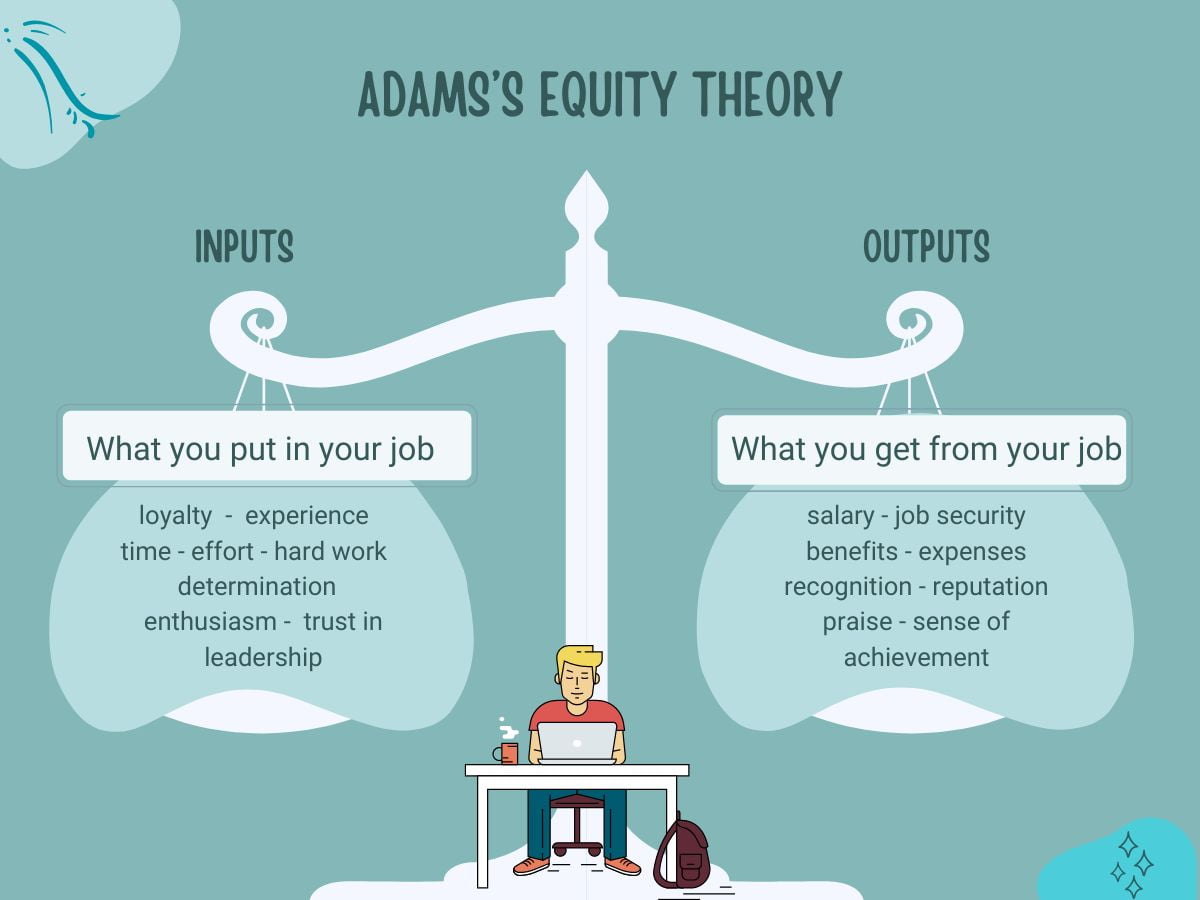
Inputs
What you put in that you view as worthy of a reward or disbenefit is called an input under Equity Theory. These could be relevant inputs like human capital and manual labour but they might also include traits like kindness and beauty which reap social rewards or cruelty and selfishness which have social costs. When considering inputs, you’ll want to look at a range of factors including loyalty, experience, education, time, effort, hard work, adaptability, ability, flexibility, determination, tolerance, enthusiasm, sacrifice, trust in leadership, skill and support from colleagues.
Outcomes
Once you look at all the inputs, you need to consider the ratio. Is one side giving more than the other? If so, someone will experience a negative outcome. However, when the ratios are close, both parties should be satisfied. To explore outputs, you’ll want to consider salary, job security, benefits, expenses, recognition, reputation, stimulus, thanks & praise and a sense of achievement. These are the rewards calculated for not just Equity Theory but many other process theories of motivation.
Equity theory in business
When applying Equity Theory in a business setting, you need to keep these 3 things in mind:
- Employees expect an equity norm or to get a fair return for their inputs.
- They gauge what’s fair by comparing against their coworkers a.k.a social comparison.
- If they feel they are not achieving equity, they will practice cognitive distortion, alter their inputs and outputs or leave.
What that means for management
Since your team will be measuring the balance of input and outcomes against their own rubric, you need to consider the individual. Employees will value outcomes and inputs differently even if all other elements (like experience, job title and qualification) are the same. A single mom might value flexible hours more while a working student might love an education bursary. This includes accounting for local economies and how far their salaries will go. If you live in Central London, you’ll expect a higher recompense than if you live in a Scottish fishing village. Also, while teams understand that you get more as you move up the ladder, excessive C-suite pay can be demotivating under Equity Theory. Lastly, employees who feel overcompensated may work harder or they could conversely develop a sense of entitlement & superiority instead. For management, you’ll need to correct any misaligned perceptions of inputs and outcomes through effective strategies to prevent dissatisfaction from brewing under Adams’s process theories of motivation.
Who was Victor Harold Vroom?
Canadian-born, Yale School of Management professor Victor Harold Vroom is a decorated PhD holder with a number of popular books on process theories of motivation including “Work and Motivation, Leadership and Decision Making” and “The New Leadership” which received academic acclaim.
What is Vroom’s Expectancy Theory?
In 1964, Vroom created the Expectancy Theory of Motivation. It’s another of the process theories of motivation and helps us understand how people act in the workplace with respect to decision-making, motivation and leadership. With this theory, performance, effort and outcomes are all separated. This is different from Maslow’s Hierarchy of Needs which links internal drivers to effort. With Vroom’s process theories of motivation around expectancy, he postulates that we all make conscious choices with our behaviour that minimises pain and results in the most pleasure. He also includes in his process theories of motivation that in the workplace, performance is also based on skills, knowledge, experience, personality and ability. Your motivation is linked to effort and performance in a system where instrumentality valence and expectancy account for motivation. We’ll explore those further below.
![Vroom’s_Expectancy_Theory[1] Vrooms Expectancy Theory](/s/img/wp-content/uploads/2024/01/Vrooms_Expectancy_Theory1.jpg)
Vroom’s 3 Variables
Expectancy
Increased effort = increased performance. That’s the core of expectancy. It’s the idea that you’ll perform better if you just work harder. However, it’s influenced by access to the right skills, resources and support. Management should set you up for success.
Instrumentality
Better performance = desired outcomes. Here we believe we’ll hit our goals if we perform better. But this is impacted by our understanding of the relationship between performance and the outcome we’ll get, whether we trust the decision makers and how transparent that reward process is.
Valence
Better rewards = better satisfaction. That’s assuming the employee values the reward at all. These exist in three categories:
- -1 Avoiding the outcome/reward
- 0 Indifferent about the outcome/reward
- +1 Wanting the outcome/reward
Obviously, valence is only motivation if your employee wants the outcome. Gamification can help to ensure that effort is rewarded with clear and desirable outcomes while showing them that expectancy and instrumentality are also factored in.
The mathematical presentation for Vroom’s Expectancy Theory is:
Motivational Force (MF) = Expectancy (E) x Instrumentality (I) x Valence (V)
Remember, if any of the factors are zero, then there will be no or low motivation. For example, if the employee can’t see how their increased effort will be rewarded (I) then they will not apply increased effort. As a result, MF is zero because I is zero.
Applying Expectancy Theory to boost motivation
Let’s say you want a sales team member to increase closed-won opportunities by 10% this quarter. Maybe you offered an incentive of one additional paid day off if this was achieved. If the employee thinks this is doable, they will likely apply more effort (E). If they trust their manager to reward them fairly and can see how increased effort leads to that goal, they’ll be motivated (I). And lastly, if they like the idea of an extra day’s holiday, they’ll work towards it (V). With all these elements aligned, the employee strives for the sales target, achieves it and is rightly rewarded.
Who was Frederick Taylor?
Frederick Winslow Taylor was a management consultant and mechanical engineer. Unlike most of the process theories of motivation originators on this list, he was not a psychologist. As one of the first management consultants in the world, he worked to make factories more efficient and published his theories in 1909 in his book, “The Principles of Scientific Management”. It’s held up as one of the most important management texts of the 20th century
What is Taylor’s Motivation Theory?
Scientific Management or Taylorism as it would become known was born in the early 1900s. It was one of the original theories of workplace motivation. It looks to improve economic efficiency and labour productivity by applying science to management. Many of the techniques are still used today like the reduction of waste, best practices, standardisation, mass production and more.
Where did Taylorism come from?
With the dawn of the 20th century came all the developments in management theory that we know and -often still- apply today. Taylorism is one of those theories. It proposed that when you optimise and simplify work, productivity increases. He’s also credited with the first theories on collaboration between employees and management. His ideas stemmed from what he viewed as inefficient practices at the time (particularly in steel). He noted that management left workers to get on with it, there was no standardisation and the only motivation was to keep a job. This meant workers didn’t have any incentive to go faster or do a great job. If you’ve heard of “a fair day’s pay for a fair day’s work” then you’re familiar with Taylorism already. That’s one of his main ideas. If you didn’t meet targets, you didn’t deserve to get as much as someone who did.
Taylor’s work in efficiency started in steel where he liked to experiment. One such experiment was changing the shape of shovels so they could be used for longer periods of time without stopping. He did another with bricklayers and how to move to more quickly lay down bricks. His overall goal was to reduce the time needed to do the task. Now, not everyone was quite as fast. So, Taylor noted that employers should choose the right people for each specific job to get the best results. He then honed these notions into Taylorism.
Taylorism in 5 principles

1. Forget precedent, add science
Don’t just do things as they’ve always been done. There are ways to study and scientifically improve work and Taylor felt his time and motion work was key to gaining efficiencies. The goal is repeatable, fast and good quality task completion that anyone can be trained to do.
2. Training smarter
Don’t expect people to learn as they go or just get stuck in. Instead, managers should teach workers the methods above on how to do each task. Don’t force the workers to think. Simply pay them to do a task as quickly and efficiently as they can.
3. Better ways of working
When managers train workers on the best way to do their jobs and then monitor them to make sure that’s happening, efficiency is improved. This oversight meant more supervisors; one for each area. The increased presence helps to maintain standards. Plus, it ensures the workers are not working less enthusiastically when no manager is around.
4. Sharing of labour
Instead of leaving workers to their own devices, it should be shared. This creates an environment where managers create the processes and enforce them. Then employees simply follow those processes to create an efficient output.
5. Pay for results
Instead of a flat rate, workers should be paid for production. If they don’t meet targets then they don’t earn as much. This piece-rate pay encourages production under Taylorism a.k.a Scientific Management.
Faults in Taylorism
Taylorism may create monotonous jobs with no autonomy that benefit the company more than the worker. Fully Scientific Management environments have caused a lot of the prior 100 years of industrial action. It’s a more dehumanising culture with no room for creativity or input.
Who was Albert Bandura?
The David Starr Jordan Professor in Psychology at Stanford University, Albert Bandura was a Canadian-American psychologist who forged inroads in social cognitive theory, personality psychology and therapy. He created the Social Learning Theory and founded the basis of self-efficacy.
What is Self-Efficacy Theory?
Albert Bandura felt that his process theories of motivation hinged on one’s own self-belief to navigate the actions needed to manage any situation. It’s this confidence in oneself which determines how we behave, think and feel. At the core of this theory is the belief that we can complete any task we set our mind to.
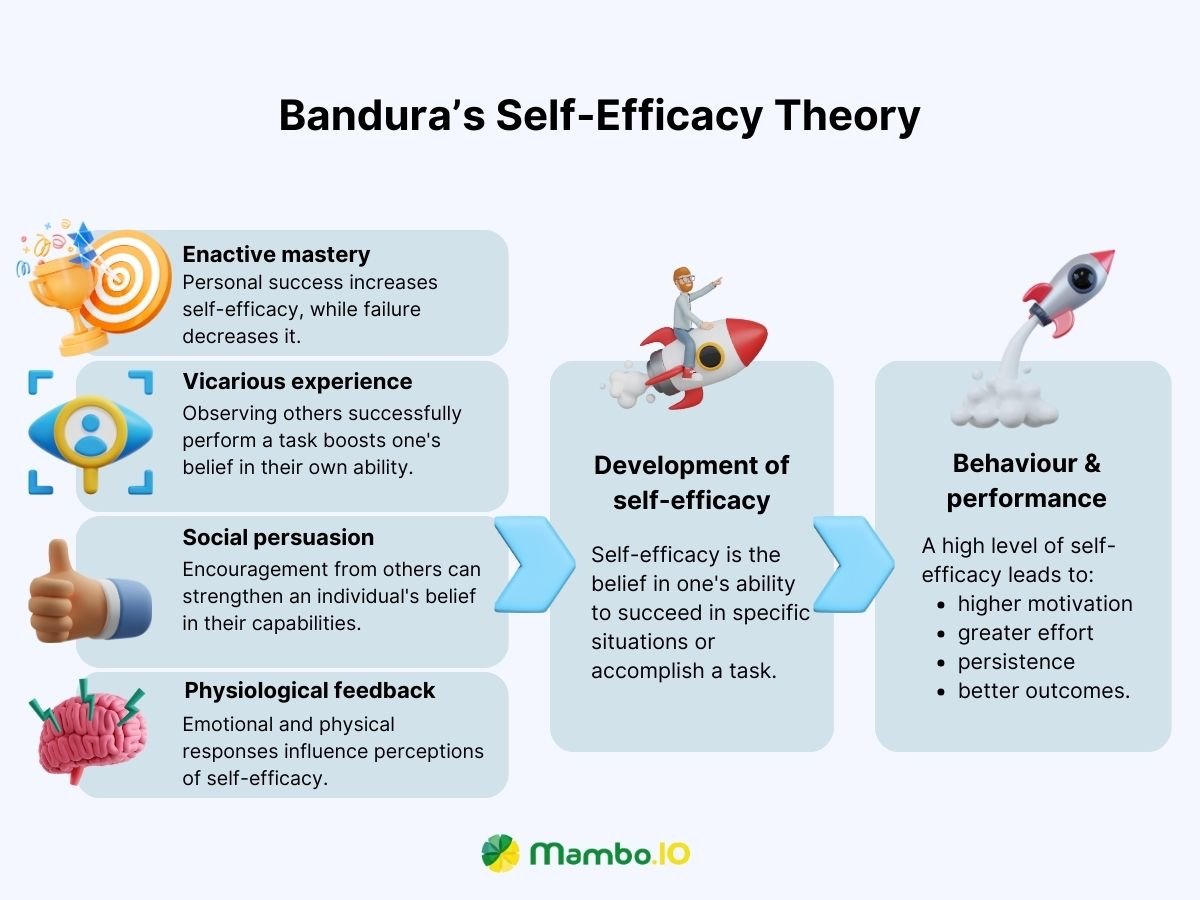
Self-Efficacy & goals
Whatever you’d like to do, change or achieve; Bandura would say your self-efficacy determines how you approach those challenges. While not easy, a high level of self-belief makes taking each requisite step simpler. If you have a strong level of self-efficacy, according to Bandura’s process theories of motivation, you’ll:
- Be more interested in the things you participate in
- Create a deeper commitment to interests
- Bounce back from setbacks faster
- Look forward to challenges
But if your self-efficacy is weak, you’ll:
- Avoid challenges
- Doubt your capabilities
- Dwell on failings and bad outcomes
- Lose confidence if things don’t turn out
Developing self-efficacy
In early childhood, according to Bakura’s process theories of motivation, we begin to form our self-efficacy. We won’t stop developing it either. It can continue to increase as we learn, grow and have new experiences. The most formative elements are:
- Mastery Experiences – doing a new task well boosts our sense of efficacy; failing decreases it.
- Social Modelling – seeing others do well can increase our self-efficacy if they’re like us.
- Social Persuasion – if others tell you that you have the skills to do the task, you can be persuaded to believe it and do well as a result.
Psychological Responses – a positive mood and low-stress levels improve our self-efficacy; poor emotional states reduce it.
How self-efficacy is different
It’s not self-esteem
Esteem is how you view yourself. It’s a state of feeling good enough. Efficacy is about doing things. It’s when you’re a match for any challenge you face. Having good self-esteem can improve your self-efficacy and vice versa, but they are not the same thing.
It’s not self-regulation
To practice good self-efficacy, you might need to regulate your behaviour. But efficacy is not the same thing as self-regulation. Self-efficacy is more about the innate belief that you’re able to succeed at any task. Self-regulation is more about learning and creating a winning strategy to reach goals. It comes after the base belief of self-efficacy.
It’s not motivation
While self-efficacy creates motivation, they’re not the same thing. Nurturing your self-efficacy can increase motivation and boost that desire to achieve. This creates a success loop where believing you’re up to the challenge manifests the effort that gets you to your goals.
It’s not resilience
People with high self-efficacy are more likely to have greater levels of resilience. However, they are not interchangeable ideas. Resilience allows you to move on from failure and bounce back. It’s a skill people with high self-efficacy have.
It’s not confidence
While very much related, confidence is not the same thing as self-efficacy. In Bandura’s process theories of motivation, he talks about confidence just being how strongly you believe something and self-efficacy being the belief itself. The more confidence you have, the more you’ll try things that give you the master experiences which build self-efficacy.
Enhancing Self-Efficacy
Looking at the four sources of self-efficacy above, there are a few ways you can boost this psychological skill:
Celebrate successes
Remember those mastery experiences? The more you revel in your accomplishments the more you’ll create a powerful belief in your own ability. Real mastery experiences aren’t easy successes either. They are hard-won victories that teach you that effort is worth it.
Live vicariously
Look at peer modelling as another source of self-efficacy. When others like you succeed through hard work, it makes it look easier for you to do as well. These observations help increase your own beliefs.
Look for feedback
Positive affirmations boost your sense of self-efficacy when they are productive and helpful. Avoid critical or negative people to prevent undermining effects. Instead, seek encouragement when you need it to get over your hurdles.
Notice your mental state
If you’re nervous, depressed or stressed; you can psych yourself out. This can lead to a negative outcome that will undermine your efficacy. Push through the fears with positive self-talk to give yourself the best chance of success.
Facing low self-efficacy?
If you don’t like to set goals or make commitments, you might be dealing with low levels of self-efficacy. If you give up quickly and lack confidence in your abilities, you may feel like a failure, lack resilience or struggle with depression. Remember that you can start to build your self-efficacy back up by looking for enhancing opportunities like the ones above.
Who was Buuhus Frederick Skinner?
A former professor of psychology at Harvard, American behaviourist and social philosopher, Buuhus Frederick Skinner was a proponent of process theories of motivation around Operant Conditioning and the principle of reinforcement. This was all outlined in the groundbreaking book – “Schedules of Reinforcement”- published in 1957.
What is Skinner’s Reinforcement Theory?
His Reinforcement Theory boils down to a fairly simple construct: If we get bad results from an action, we’ll stop doing it. Likewise, if we get a good outcome, we’ll probably do it more. With the Skinner box, he measured the rate of response to this conditioning – a practice which would then birth behaviour analysis.
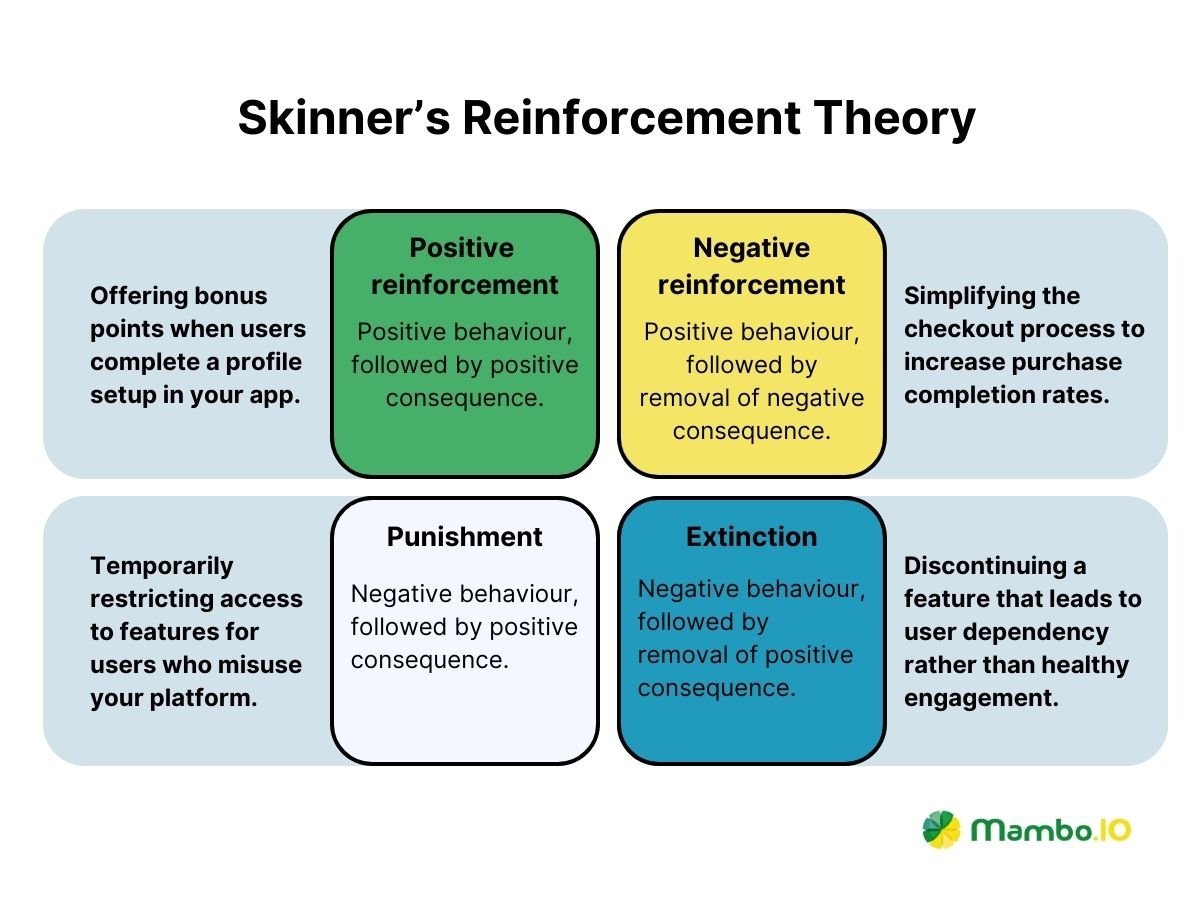
What Is Operant Conditioning?
In order to measure responses, Skinner used operant or instrumental conditioning. It uses rewards and disbenefits as a result of behaviour. This creates a link in the subject’s mind between good or bad outcomes and a particular action. Think lab rats that get a food pellet when they press a lever with a green light above it and a shock when they press a lever with a red light above it. They’d soon learn to avoid the red light. This is the same for humans and Operant Conditioning takes place informally in classrooms, therapy sessions and workplaces all over the country.
The History of Operant Conditioning
Skinnerian Conditioning or Operant Conditioning is one of the few process theories of motivation that are totally external. It looks at the observable causes of human behaviour (outcomes) to determine what people will do next. With a good outcome, the behaviour is likely to be repeated. And with a bad one, avoided. The more that the same type of outcome happens, the more likely you will be conditioned to believe it always will happen. If you are disruptive in a work meeting and your boss glares at you, you’re unlikely to attempt that again – especially if you see the same outcome happening to others or if it has happened before.
Types of Behaviours
The two types of behaviours that Skinner identified with his process theories of motivation are respondent and operant.
Respondent behaviours
They are automatic and instinctual reactions like jerking your hand out of boiling water. They aren’t learned.
Operant behaviours
These behaviours are determined by thought and often influenced by consequences we’ve experienced in the past. They’re an important part of learning. Skinner used his operant conditioning chamber or Skinner box to track and record the response rates of animals who found pressing a key inside gave a reward.
Operant Conditioning elements
Within Operant Conditioning are a few key concepts:
Reinforcement in Operant Conditioning
Reinforcement increases behaviour and there are two kinds:
- Positive reinforcers- this is when you get a reward after the behaviour like praise for a job well done.
- Negative reinforcers- this removes a bad outcome following the behaviour like giving your kid a candy to shush them. This gives you respite from the bad outcome of their tantrum.
Operant Conditioning punishments
Punishments decrease behaviours and there are two kinds:
- Positive punishment – with this punishment, the goal is to train out the preceding behaviour. Spanking a child is an example of this and it’s also called punishment by application.
- Negative punishment – this is when you take something good away after a preceding behaviour and it’s sometimes called punishment by removal. Taking away the iPad when your teenager won’t clean their room is an example.
Reinforcement Schedules
Want to ensure your reinforcement works? The frequency and timing of your reinforcement make all the difference. According to Skinner, these schedules of reinforcement matter:
- If you continuously reinforce with rewards the learning is faster but the response rate is low and the participant will forget quickly.
- If you use a fixed rate schedule and reinforce after a specific number of responses, this leads to a steady response rate. Think of milestones.
- Fixed interval uses a time break in between responses. This creates a bell curve of response rates as they increase nearer the time and decrease when further away from the reward.
- Variable ratio schedules add reinforcement after a random number of responses. This results in a slow extinction (forgetfulness) rate and a high response rate.
- Lastly, variable interval schedules give reinforcement after a random amount of time and it’s just as effective as a variable ratio reinforcement schedule.
Examples of Operant Conditioning in business
Here are two examples of operant conditioning at work:
- New learners are navigating a gamified onboarding training module. When they finish the chapter, they get a badge for completion and the facilitator gives them verbal praise. This will create conditioning which encourages them to complete more modules.
- Sales agents are struggling to meet their quotas for the week and are advised they’ll need to work on Saturday. The manager says, alternatively if they just get two more sales on Friday, he won’t make them come in on the weekend. This operates as negative reinforcement, removing a bad outcome for the team when they meet the stretch target.
Who was Edwin Locke?
The former University of Maryland Dean’s Professor of Motivation and Leadership at the Robert H. Smith School of Business is an accomplished American psychologist. He pioneered his goal-setting process theories of motivation in 1968 to explain workplace behaviour.
What is Locke’s Goal-Setting Theory?
Locke’s article “Toward a Theory of Task Motivation and Incentives” from 1968 is the template for modern goal-setting. It explains that when you create clear goals and give relevant feedback then your teams will be motivated. He also felt that other process theories of motivation overlooked the value of working towards a goal as a big source of motivation and performance improvement. This is doubly true for specific and challenging goals. Telling someone to just do their best is far less effective than telling them to beat their best score. Several years later, Dr Gary Latham would do studies which supported Locke’s work and they’d collaborate on the 1990 influential book, “A Theory of Goal Setting & Task Performance.” This is the foundation for most goal-based management techniques today.
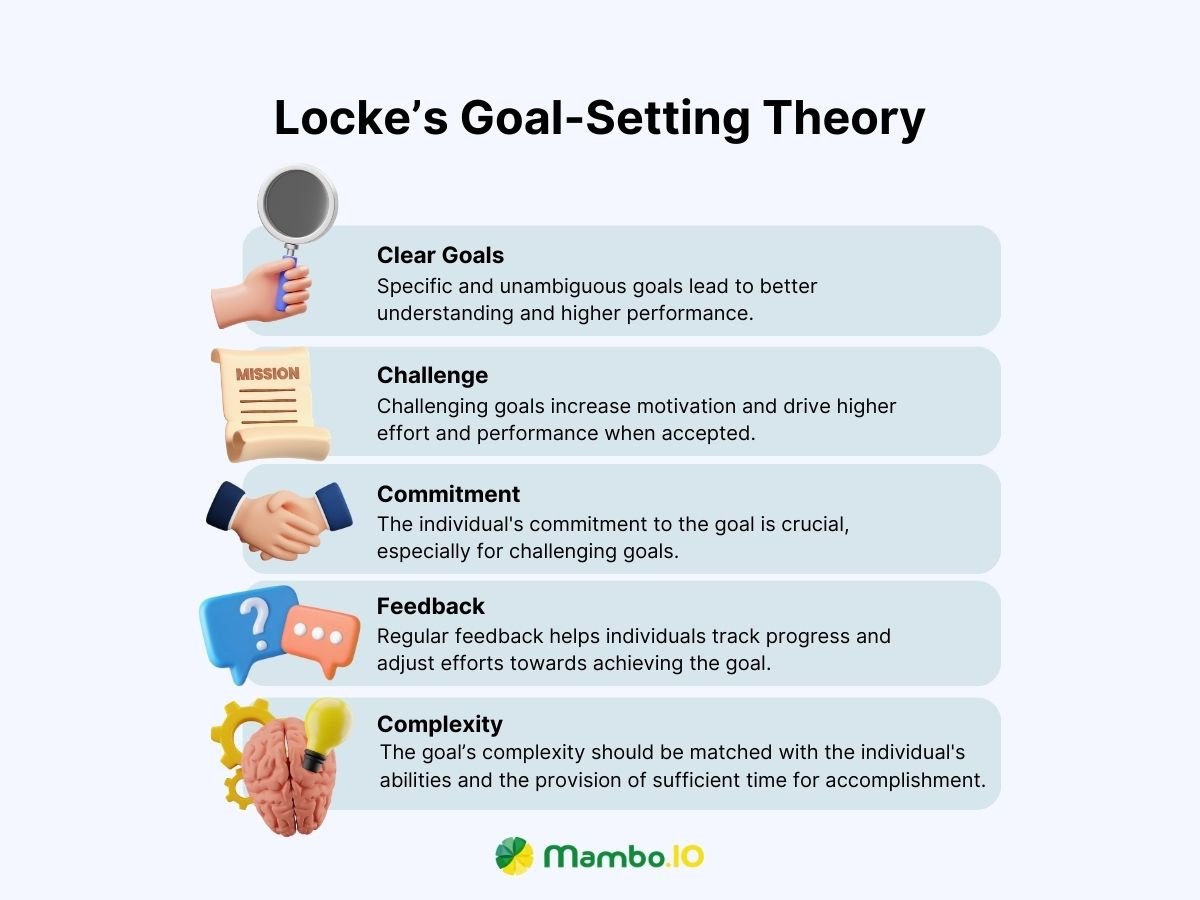
Goal-Setting Theory’s 5 principles
To improve your chances of a good outcome you need a challenge, clarity, commitment, feedback and complexity. Here’s what those mean:
- Clarity – when you know what you want to get to, you can set accurate measurements and rewards. Think of the SMART mnemonic. Your goal setting needs to be specific, measurable, attainable, relevant and time-bound.
- Challenging – Use the inverted U model to create a balance between pressure and performance. Think about how you might use gamification to create healthy competition and how to scale the rewards so they are relevant.
- Commitment – Make sure everyone has bought into the goals. This is easier if they help to set them. You might use MBO or Amabile and Kramer’s Progress Theory to help everyone get on board.
- Feedback – Are you listening? Measuring your own progress and checking with your team helps you manage expectations and tweak the milestones in real-time. Try the stop, start and continue method to give and receive relevant feedback.
- Complexity – Are there too many moving parts? Try breaking the goal down into sub-goals or milestones so it’s not too overwhelming for your team. Check-in regularly to see how they’re doing. You can always make more sub-goals to give them positive reinforcement as they accomplish each step towards the main goal.